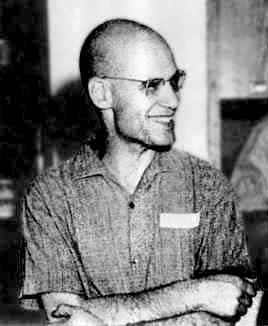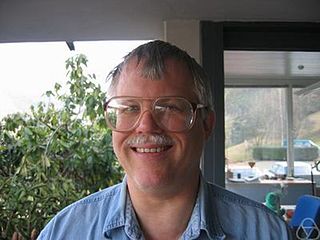
Alexander Grothendieck was a German-born mathematician who became the leading figure in the creation of modern algebraic geometry. His research extended the scope of the field and added elements of commutative algebra, homological algebra, sheaf theory, and category theory to its foundations, while his so-called "relative" perspective led to revolutionary advances in many areas of pure mathematics. He is considered by many to be the greatest mathematician of the twentieth century.

Algebraic topology is a branch of mathematics that uses tools from abstract algebra to study topological spaces. The basic goal is to find algebraic invariants that classify topological spaces up to homeomorphism, though usually most classify up to homotopy equivalence.

Vladimir Alexandrovich Voevodsky was a Russian-American mathematician. His work in developing a homotopy theory for algebraic varieties and formulating motivic cohomology led to the award of a Fields Medal in 2002. He is also known for the proof of the Milnor conjecture and motivic Bloch–Kato conjectures and for the univalent foundations of mathematics and homotopy type theory.
In algebraic geometry, motives is a theory proposed by Alexander Grothendieck in the 1960s to unify the vast array of similarly behaved cohomology theories such as singular cohomology, de Rham cohomology, etale cohomology, and crystalline cohomology. Philosophically, a "motif" is the "cohomology essence" of a variety.
Daniel Gray Quillen was an American mathematician. He is known for being the "prime architect" of higher algebraic K-theory, for which he was awarded the Cole Prize in 1975 and the Fields Medal in 1978.
Algebraic K-theory is a subject area in mathematics with connections to geometry, topology, ring theory, and number theory. Geometric, algebraic, and arithmetic objects are assigned objects called K-groups. These are groups in the sense of abstract algebra. They contain detailed information about the original object but are notoriously difficult to compute; for example, an important outstanding problem is to compute the K-groups of the integers.
Motivic cohomology is an invariant of algebraic varieties and of more general schemes. It is a type of cohomology related to motives and includes the Chow ring of algebraic cycles as a special case. Some of the deepest problems in algebraic geometry and number theory are attempts to understand motivic cohomology.
In mathematics, particularly in homotopy theory, a model category is a category with distinguished classes of morphisms ('arrows') called 'weak equivalences', 'fibrations' and 'cofibrations' satisfying certain axioms relating them. These abstract from the category of topological spaces or of chain complexes. The concept was introduced by Daniel G. Quillen.
In mathematics, the Milnor conjecture was a proposal by John Milnor of a description of the Milnor K-theory (mod 2) of a general field F with characteristic different from 2, by means of the Galois cohomology of F with coefficients in Z/2Z. It was proved by Vladimir Voevodsky.
In mathematics, higher category theory is the part of category theory at a higher order, which means that some equalities are replaced by explicit arrows in order to be able to explicitly study the structure behind those equalities. Higher category theory is often applied in algebraic topology, where one studies algebraic invariants of spaces, such as the fundamental weak ∞-groupoid.
In algebraic geometry and algebraic topology, branches of mathematics, A1homotopy theory or motivic homotopy theory is a way to apply the techniques of algebraic topology, specifically homotopy, to algebraic varieties and, more generally, to schemes. The theory is due to Fabien Morel and Vladimir Voevodsky. The underlying idea is that it should be possible to develop a purely algebraic approach to homotopy theory by replacing the unit interval [0, 1], which is not an algebraic variety, with the affine line A1, which is. The theory has seen spectacular applications such as Voevodsky's construction of the derived category of mixed motives and the proof of the Milnor and Bloch-Kato conjectures.
This is a timeline of category theory and related mathematics. Its scope is taken as:
In mathematics, especially (higher) category theory, higher-dimensional algebra is the study of categorified structures. It has applications in nonabelian algebraic topology, and generalizes abstract algebra.

Ronald Brown FLSW is an English mathematician. Emeritus Professor in the School of Computer Science at Bangor University, he has authored many books and more than 160 journal articles.
In mathematics, the norm residue isomorphism theorem is a long-sought result relating Milnor K-theory and Galois cohomology. The result has a relatively elementary formulation and at the same time represents the key juncture in the proofs of many seemingly unrelated theorems from abstract algebra, theory of quadratic forms, algebraic K-theory and the theory of motives. The theorem asserts that a certain statement holds true for any prime and any natural number . John Milnor speculated that this theorem might be true for and all , and this question became known as Milnor's conjecture. The general case was conjectured by Spencer Bloch and Kazuya Kato and became known as the Bloch–Kato conjecture or the motivic Bloch–Kato conjecture to distinguish it from the Bloch–Kato conjecture on values of L-functions. The norm residue isomorphism theorem was proved by Vladimir Voevodsky using a number of highly innovative results of Markus Rost.

In mathematical logic and computer science, homotopy type theory (HoTT) refers to various lines of development of intuitionistic type theory, based on the interpretation of types as objects to which the intuition of (abstract) homotopy theory applies.

Charles Alexander Weibel is an American mathematician working on algebraic K-theory, algebraic geometry and homological algebra.
This is a glossary of properties and concepts in algebraic topology in mathematics.
In algebraic topology, the fundamental groupoid is a certain topological invariant of a topological space. It can be viewed as an extension of the more widely-known fundamental group; as such, it captures information about the homotopy type of a topological space. In terms of category theory, the fundamental groupoid is a certain functor from the category of topological spaces to the category of groupoids.
[...] people still obstinately persist, when calculating with fundamental groups, in fixing a single base point, instead of cleverly choosing a whole packet of points which is invariant under the symmetries of the situation, which thus get lost on the way. In certain situations it is much more elegant, even indispensable for understanding something, to work with fundamental groupoids with respect to a suitable packet of base points, [,,,]
Mikhail Kapranov, is a Russian mathematician, specializing in algebraic geometry, representation theory, mathematical physics, and category theory. He is currently a professor of the Kavli Institute for the Physics and Mathematics of the Universe at the University of Tokyo.





